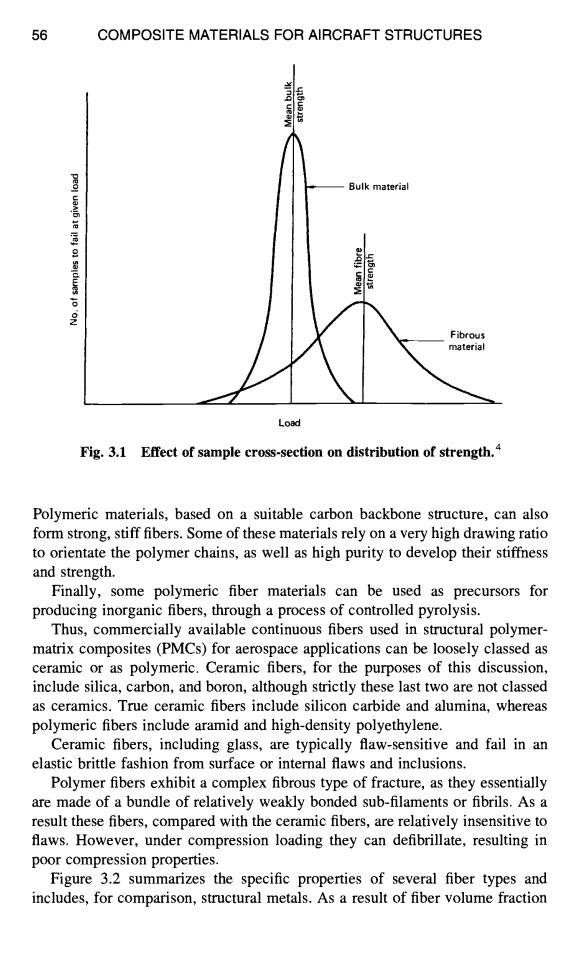正在加载图片...

56 COMPOSITE MATERIALS FOR AIRCRAFT STRUCTURES ing ueaw Bulk material Fibrous material Load Fig.3.1 Effect of sample cross-section on distribution of strength.4 Polymeric materials,based on a suitable carbon backbone structure,can also form strong,stiff fibers.Some of these materials rely on a very high drawing ratio to orientate the polymer chains,as well as high purity to develop their stiffness and strength. Finally,some polymeric fiber materials can be used as precursors for producing inorganic fibers,through a process of controlled pyrolysis. Thus,commercially available continuous fibers used in structural polymer- matrix composites (PMCs)for aerospace applications can be loosely classed as ceramic or as polymeric.Ceramic fibers,for the purposes of this discussion, include silica,carbon,and boron,although strictly these last two are not classed as ceramics.True ceramic fibers include silicon carbide and alumina,whereas polymeric fibers include aramid and high-density polyethylene. Ceramic fibers,including glass,are typically flaw-sensitive and fail in an elastic brittle fashion from surface or internal flaws and inclusions. Polymer fibers exhibit a complex fibrous type of fracture,as they essentially are made of a bundle of relatively weakly bonded sub-filaments or fibrils.As a result these fibers,compared with the ceramic fibers,are relatively insensitive to flaws.However,under compression loading they can defibrillate,resulting in poor compression properties. Figure 3.2 summarizes the specific properties of several fiber types and includes,for comparison,structural metals.As a result of fiber volume fraction56 COMPOSITE MATERIALS FOR AIRCRAFT STRUCTURES O 5 Z Fig. 3.1 === co • - Bulk material ~ Fibrous Load Effect of sample cross-section on distribution of strength. 4 Polymeric materials, based on a suitable carbon backbone structure, can also form strong, stiff fibers. Some of these materials rely on a very high drawing ratio to orientate the polymer chains, as well as high purity to develop their stiffness and strength. Finally, some polymeric fiber materials can be used as precursors for producing inorganic fibers, through a process of controlled pyrolysis. Thus, commercially available continuous fibers used in structural polymermatrix composites (PMCs) for aerospace applications can be loosely classed as ceramic or as polymeric. Ceramic fibers, for the purposes of this discussion, include silica, carbon, and boron, although strictly these last two are not classed as ceramics. True ceramic fibers include silicon carbide and alumina, whereas polymeric fibers include aramid and high-density polyethylene. Ceramic fibers, including glass, are typically flaw-sensitive and fail in an elastic brittle fashion from surface or internal flaws and inclusions. Polymer fibers exhibit a complex fibrous type of fracture, as they essentially are made of a bundle of relatively weakly bonded sub-filaments or fibrils. As a result these fibers, compared with the ceramic fibers, are relatively insensitive to flaws. However, under compression loading they can defibrillate, resulting in poor compression properties. Figure 3.2 summarizes the specific properties of several fiber types and includes, for comparison, structural metals. As a result of fiber volume fraction